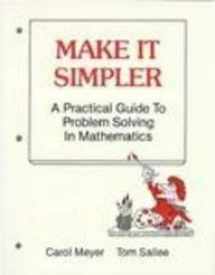
Make It Simpler a Practical Guide to Problem Solving in Mathematics
Book details
Summary
Description
The authors state that "the approach you will find in this book is based on the following beliefs: 1. The developmental theorists (Plaget, Burner, et al) are essentially correct in their understanding of how minds mature as children grow. 2. It follows from these theorists that the ages ten to fourteen are crucial in the development of adult thinking styles. 3. Children can be taught to reason well. What is needed is an effective way to teach a whole classroom full of children to reason well. 4. Learning requires interaction with someone else. 5. Learning a relatively few reasoning techniques will enable an individual to deal effectively with most types of problems. 6. The major barrier to effective problem solving is psychological rather than intellectual. From these beliefs, the authors developed a two-pronged approach for children of the appropriate ages. First, almost all activities must take place in a group setting. Second, the students are taught a sequence of necessary skills: understanding a problem, learning general strategies and selecting an appropriate strategy. Within these groups the students learn the basics of solving problems, beginning with the idea that problem solving is not such a difficult skill after all. A wide variety of activities are used beginning with open questions and gradually moving toward questions which have a definite solution. Many of these activities are in the form of games to increase student interaction and hypothesis testing within the group."


We would LOVE it if you could help us and other readers by reviewing the book
Book review



